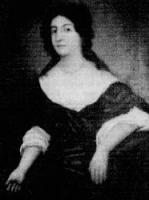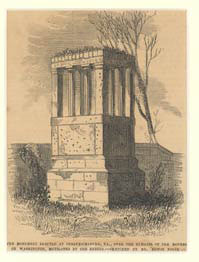By Barbara Crookshanks
Fredericksburg's Mary Ball Washington was an intrepid 18th-century woman who raised five children alone. The oldest became the first President of the United States.
Mary Washington's name and heritage are alive and well in the Fredericksburg area and beyond. Her home is at the corner of Lewis and Charles streets; the Mary Washington Monument is on Washington Avenue, which was originally Mary Washington Avenue.
Mary, her husband Augustine, and their children first lived at Pope's Creek (now George Washington Birthplace National Monument in Westmoreland County) and then at the Stafford County plantation which is now George Washington's Ferry Farm.
Image courtesy of the Sons of the American Revolution. This portrait of Mary Ball is exhibited in the Courthouse at Lancaster, Virginia and appeared in SAR Magazine, Winter 2000.
When Fredericksburg's Mary Washington College prepared for university status, burgundy bumper stickers and buttons proclaimed "Virginia's next great university...University of Mary Washington." Ever-expanding Mary Washington Hospital has borne her name since its founding.
Many writers have painted word pictures of the "First Mother." Some are flattering; others are not. Historian Paula S. Felder, known for her meticulous research, gives a balanced and factual view in her book, Fielding Lewis and the Washington Family:
"She was a simply educated woman with no great social polish or breadth." Furthermore, "She was evidently a stern parent, presiding over her household with a rudimentary common sense which some have characterized as stubbornness."
Mary Ball was born in 1708 or 1709 in Lancaster County, Virginia, the only child of Joseph Ball and his second wife, Mary Johnson. Sentimental biographers dubbed her "The Belle of Epping Forest," after her father's estate.
Mary would marry Augustine Washington, of Pope's Creek, Westmoreland County, on March 6, 1731. A widower with three children, he was a leader in area iron mining enterprises.
George was the first of their five children, born February 22, 1732. They settled at what is now Ferry Farm in 1738. Mary was widowed at age 35 when Augustine died in April of 1743.
Paula Felder writes that "The family had the necessities of life but not much more." She also notes that Mary had an independence of spirit which may have helped her overcome some of the problems faced by an 18th-century single mother.
As the years passed, Mary energetically managed the 600-acre farm. When necessary she could be a stern parent as illustrated by her refusal to allow George to join the British Navy.
George purchased what would be Mary's Fredericksburg home in 1772. She was now 64 and the farm was becoming too much of a task. The Marquis de Lafayette, French hero of the American Revolution and George's friend, would visit her in this new home on Charles Street.
In 1773, a neighbor wrote that she was "active and sprightly," visiting neighbors with a cane in her hand. He said she talked of George without the least bit of pride or vanity and used a riding chair he had purchased for her in Philadelphia.
Mary Ball Washington died on August 25, 1789, and was buried on the Lewis plantation a few steps from Meditation (Oratory) Rock, which tradition says was her favorite retreat for reading, prayer, and meditation.
Members of Congress wore black crepe armbands for Mary for 30 days and passed a resolution to erect a monument on her grave. However, when Lafayette returned to Fredericksburg in 1825 he saw only an uncared-for small marble tombstone in the middle of a cornfield.
Local Presbyterians wanted to move Mary's remains to their new church but Episcopalians said she would not be able to rest in peace in a Presbyterian church.
Meanwhile, a rich New Yorker offered to pay for "an elegant monument" for Mary's current resting place. At the cornerstone dedication in 1833, President Andrew Jackson called Mary "this illustrious example of maternal devotion."
Four years later work on the monument was suddenly abandoned. Fifty years later the monument was a heap of rubble. It was to have been a Doric-columned Greek temple topped by a bust of George Washington with an eagle soaring over his head.
Two events within two years seemed destined to efface Mary Washington's memory. However, they both turned out to have silver linings.
In 1890, the Mary Washington House was almost sold to the Chicago Columbia Exposition but was saved by the Association for the Preservation of Virginia Antiquities (Now Preservation Virginia). This was the impetus for the restoration of the house as a tourist attraction and for the formation of the Fredericksburg Branch APVA.
The year 1889 was the time of the "Terrible Advertisement." Mary Washington's grave and the 12 acres around it were to be sold at public auction. Local and national outrage led to the formation of the Fredericksburg and National Mary Washington Monument Associations.
Plans were soon underway to build "the first monument ever erected by women to a woman." Fundraisers ranged from simple Fredericksburg events to lavish national events, including balls and entertainments in New Orleans, Baltimore, Charleston, S.C., Denver, and White Sulphur Springs.
On May 10, 1894, President Grover Cleveland was on hand for the dedication of the new Mary Washington Monument. More than 50 feet high, it is an obelisk of Vermont granite with the simple words, Mary, Mother of Washington.
Additional views of the monument are available from our Postcard Collection.
In the Library:
Ball Families of Virginia's Northern Neck: An Outline compiled by Margaret Lester Hill.
A genealogy researched at the request of the Mary Ball Washington Museum and Library.
Fielding Lewis and the Washington Family: A Chronicle of 18th Century Fredericksburg by Paula S. Felder.
Mary lived within a short walk of her daughter, Betty, and her son-in-law, Fielding Lewis. This recent book gives a narrative of the familial relations as well as reproductions of period documents.
George Washington's Mother by Jean Fritz.
A perfect book to share with early readers who want to know more about Mary Washington's life and her relationship with her famous son.
Places to Visit on the Web:
George Washington Birthplace National Monument
The National Park Service site, beautifully situated on the banks of Pope's Creek, has recreated a typical plantation house and outbuildings of the Washingtons' time and often has special programs.
George Washington Papers at the Library of Congress
More than 65,000 documents may be browsed by date or searched by keywords. Includes transcriptions.
In an address to the citizens of Fredericksburg, file dated February 14, 1784, George wrote "...the honorable mention wch. is made of my revered Mother; by whose Maternal hand (early deprived of a Father) I was led from childhood."
George Washington's Ferry Farm
Ferry Farm was acquired in recent years by George Washington's Fredericksburg Foundation. The spacious property alongside of the Rappahannock River is open to the public and has programs for scholars and young students.
Mary Washington House
This charming historic property, the last home of Mary Ball Washington, is open to the public throughout the year.
The Mary Ball Washington Museum and Library
This museum is named in her honor. Researchers, take note: their Web page has a searchable database of their genealogy titles.





